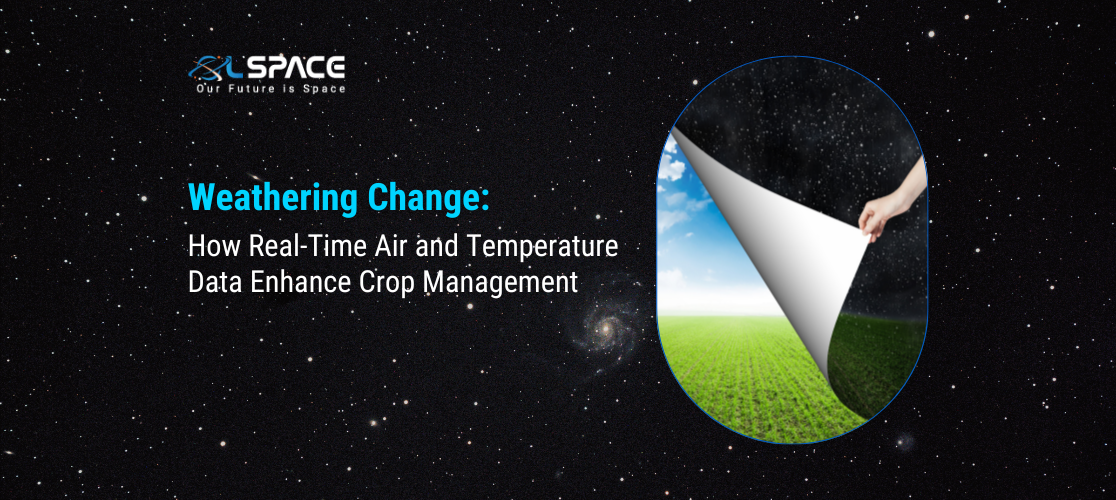16 February 2024
Weathering Change: How Real-Time Air and Temperature Data Enhance Crop Management

In modern agriculture, the ability to monitor and respond to changing weather conditions is crucial for optimising crop yields, resource usage, and farm profitability. Real-time air and temperature data play a significant role in providing farmers with timely insights to make informed decisions about irrigation, planting, harvesting, and pest management. This article explores how the integration of real-time weather data enhances crop management practices and contributes to sustainable agriculture.
Precision Farming Practices:
Real-time air and temperature data enable precision farming practices by providing farmers with up-to-date information about localised weather conditions. By monitoring temperature fluctuations and air moisture levels in real-time, farmers can adjust irrigation schedules, fertiliser applications, and pest control measures to meet the specific needs of their crops.
Optimised Irrigation Management:
Accurate air and temperature data help farmers optimise irrigation management by determining the timing and quantity of water application based on crop water requirements and prevailing weather conditions. By avoiding under or over-watering, farmers can conserve water resources, reduce irrigation costs, and maximise crop productivity.
Early Detection of Weather-Related Risks:
Real-time air and temperature data facilitate early detection of weather-related risks such as frost, heat stress, and humidity extremes, which can adversely affect crop health and yield. By receiving timely alerts and notifications, farmers can implement proactive measures to mitigate risks and minimise crop losses.
Crop Phenology Monitoring:
Continuous monitoring of air temperature data allows farmers to track crop phenology and growth stages accurately. By correlating temperature data with crop development models, farmers can predict key growth milestones such as flowering, fruit set, and maturity, enabling timely management interventions and harvest planning.
Integrated Pest and Disease Management:
Air temperature data plays a critical role in integrated pest and disease management by influencing pest life cycles, disease progression, and crop susceptibility. By monitoring temperature thresholds for pest development and disease spread, farmers can implement targeted control measures and reduce reliance on chemical inputs.
Climate Smart Agriculture:
Real-time air and temperature data support climate-smart agriculture practices by helping farmers adapt to changing climatic conditions and mitigate the impacts of climate change on crop production. By leveraging weather data to inform crop selection, planting dates, and agronomic practices, farmers can build resilience and sustainability into their farming systems.
Resource Efficiency and Cost Savings:
By optimising crop management decisions based on real-time weather data, farmers can improve resource efficiency and achieve cost savings across inputs such as water, energy, and agrochemicals. Smart irrigation scheduling, temperature-based pest forecasting, and weather-informed crop planning contribute to higher resource-use efficiency and economic returns.
Data-Driven Decision Making:
Real-time air and temperature data empower farmers to make data-driven decisions about crop management, enabling them to respond quickly to changing environmental conditions and market dynamics. By leveraging weather data alongside field observations and agronomic knowledge, farmers can optimise yields, quality, and profitability.
Accessibility and Adoption:
Advances in sensor technology, data analytics, and mobile applications have made real-time weather data more accessible and user-friendly for farmers of all scales and regions. By providing intuitive interfaces, actionable insights, and localised forecasts, weather data platforms promote widespread adoption and integration into farm management practices.
Collaboration and Extension Services:
Collaboration between agricultural extension services, research institutions, and private sector stakeholders facilitates the dissemination of real-time weather data and best practices to farmers. Extension programs, training workshops, and knowledge-sharing platforms help farmers leverage weather data effectively and adopt climate-resilient farming strategies.
Conclusion:
Real-time air and temperature data offer invaluable insights for enhancing crop management practices and promoting sustainable agriculture. By leveraging weather data to inform irrigation, pest management, phenology monitoring, and climate adaptation strategies, farmers can optimise yields, conserve resources, and mitigate risks associated with weather variability and climate change. As the agriculture sector continues to embrace digital technologies and data-driven approaches, the integration of real-time weather data will play an increasingly vital role in shaping the future of farming and food production.
